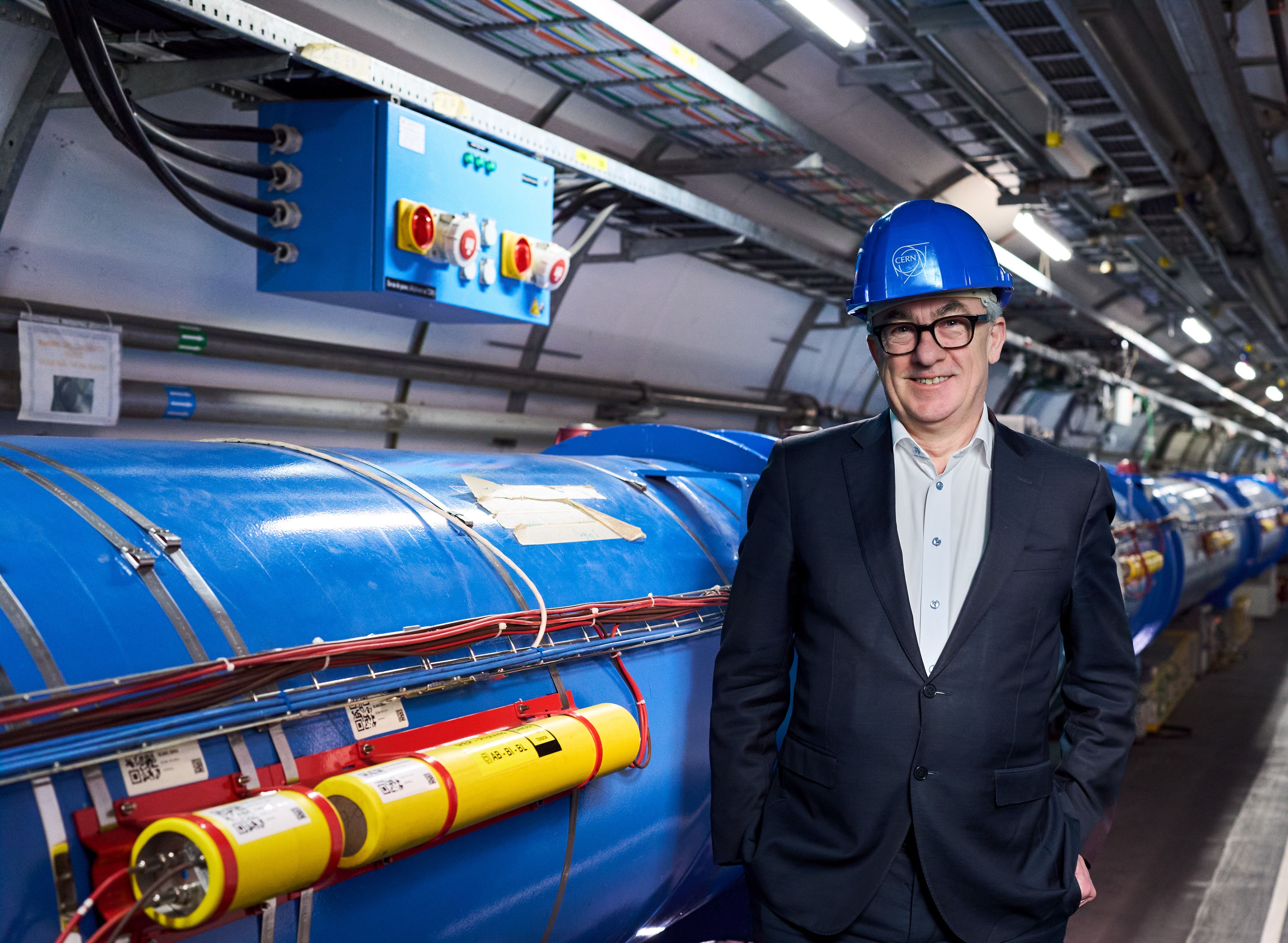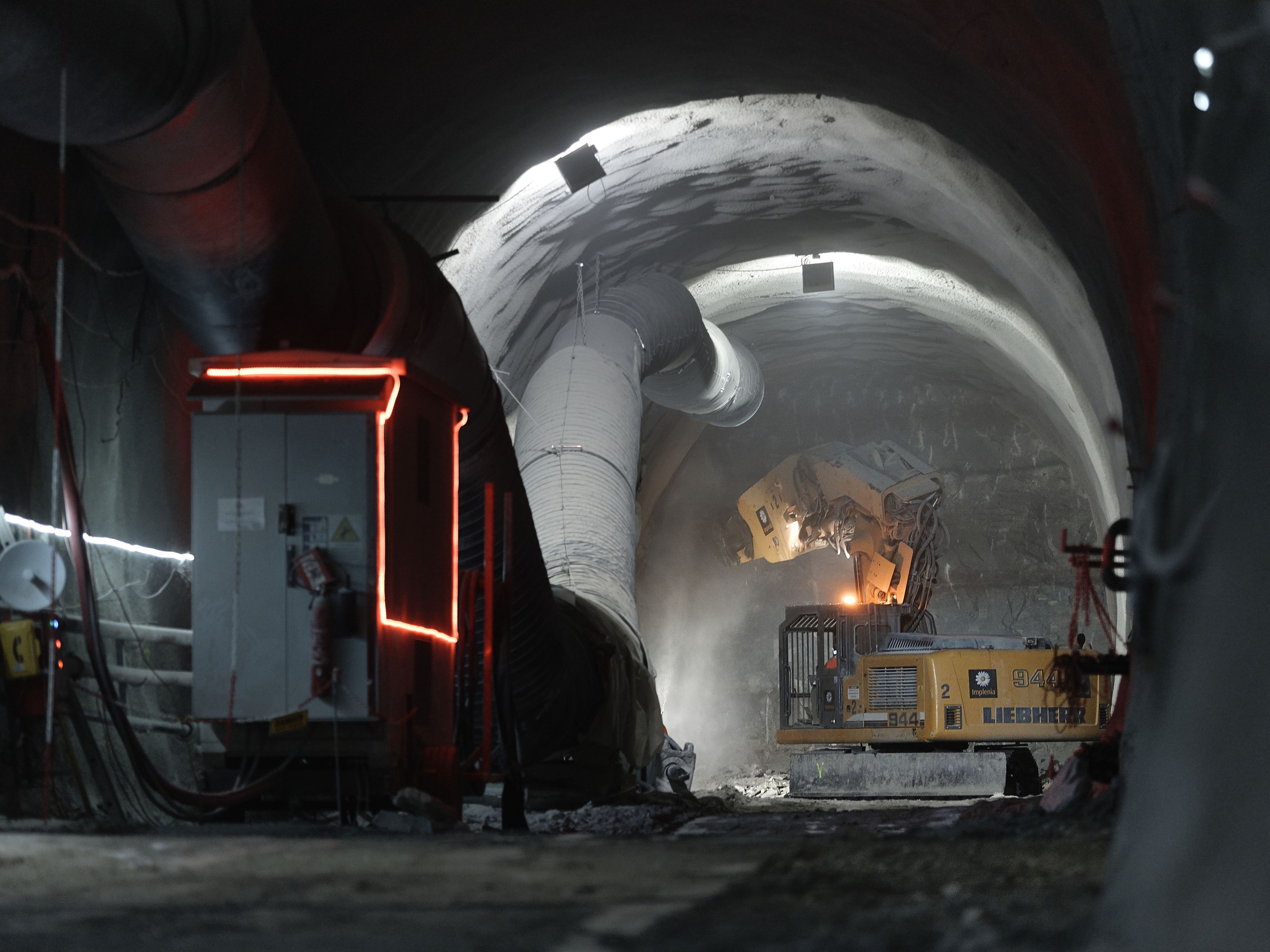CERN’s next Director-General
By Harry Cliff

The Cavendish’s very own Mark Thomson will become Director-General of CERN at the start of 2026. In this interview, he lays out his vision for the international laboratory as European physicists prepare for life after the Large Hadron Collider.
It’s rare to bump into Mark Thomson in the Cavendish Laboratory these days. After joining as a lecturer in 2000 and becoming a professor in 2008, Mark’s career has increasingly taken him away from Cambridge.
In 2015, he became co-spokesperson of the Deep Underground Neutrino Experiment (DUNE), the largest particle physics project ever undertaken in the USA. Then from 2018 to 2024, he served as Executive Chair of the Science and Technology Facilities Council (STFC), the UK government agency that supports science and engineering research, including particle physics and astronomy. Now, he is preparing to take on the biggest job in physics: Director-General of CERN.
Mark will come into post at a critical time for the world’s leading particle physics laboratory. The European particle physics community is in the midst of developing its strategy for a future after the Large Hadron Collider, at a time when the international environment is less stable and predictable than it has been for a generation.
So, when Mark visited to the newly completed Ray Dolby Centre on a sunny day in April to give the keynote speech at an Institute of Physics conference, I took the opportunity to sit down with him to discuss his priorities as the incoming Director-General and get his view of the current state of the field. He began by responding to the oft-heard argument that particle physics has reached an impasse or dead-end following the discovery of the Higgs boson at CERN’s Large Hadron Collider (LHC) in 2012.
“Sometimes, I hear these messages that high energy physics is in the doldrums. Absolutely not true!” he began emphatically. “If you look back 30 years, we’ve seen really big, profound discoveries – the Higgs boson, neutrino masses – every seven, eight years. That’s a pretty good hit rate for fundamental discovery.” This critique of particle physics, and the Large Hadron Collider in particular, stems largely from the fact that aside from the Higgs, the LHC has not revealed any new particles that might address big mysteries like dark matter or the imbalance of matter and antimatter in the universe, mysteries emphasised by the messaging around the launch of CERN’s shiny new 27 kilometre, €4.6 billion collider in 2008.
The ATLAS experiment at CERN’s Large Hadron Collider, one of the two detectors used to discover the Higgs boson. Credit: CERN
The ATLAS experiment at CERN’s Large Hadron Collider, one of the two detectors used to discover the Higgs boson. Credit: CERN
It’s rare to bump into Mark Thomson in the Cavendish Laboratory these days. After joining as a lecturer in 2000 and becoming a professor in 2008, Mark’s career has increasingly taken him away from Cambridge.
In 2015, he became co-spokesperson of the Deep Underground Neutrino Experiment (DUNE), the largest particle physics project ever undertaken in the USA. Then from 2018 to 2024, he served as Executive Chair of the Science and Technology Facilities Council (STFC), the UK government agency that supports science and engineering research, including particle physics and astronomy. Now, he is preparing to take on the biggest job in physics: Director-General of CERN.
Mark will come into post at a critical time for the world’s leading particle physics laboratory. The European particle physics community is in the midst of developing its strategy for a future after the Large Hadron Collider, at a time when the international environment is less stable and predictable than it has been for a generation.
“The real breakthrough was the Higgs, but we should not be expecting massive breakthroughs every few years. Science doesn’t work like that.”
So, when Mark visited to the newly completed Ray Dolby Centre on a sunny day in April to give the keynote speech an Institute of Physics conference, I took the opportunity to sit down with him to discuss his priorities as the incoming Director-General and get his view of the current state of the field. He began by responding to the oft-heard argument that particle physics has reached an impasse or dead-end following the discovery of the Higgs boson at CERN’s Large Hadron Collider (LHC) in 2012.
“Sometimes, I hear these messages that high energy physics is in the doldrums. Absolutely not true!” he began emphatically. “If you look back 30 years, we’ve seen really big, profound discoveries – the Higgs boson, neutrino masses – every seven, eight years. That’s a pretty good hit rate for fundamental discovery.” This critique of particle physics, and the Large Hadron Collider in particular, stems largely from the fact that aside from the Higgs, the LHC has not revealed any new particles that might address big mysteries like dark matter or the imbalance of matter and antimatter in the universe, mysteries emphasised by the messaging around the launch of CERN’s shiny new 27 kilometre, €4.6 billion collider in 2008.
The ATLAS experiment at CERN’s Large Hadron Collider, one of the two detectors used to discover the Higgs boson. Credit: CERN
The ATLAS experiment at CERN’s Large Hadron Collider, one of the two detectors used to discover the Higgs boson. Credit: CERN
“The real breakthrough was the Higgs, but we should not be expecting massive breakthroughs every few years. Science doesn’t work like that.”
But for Mark, the LHC has had an incredible impact, in particular through its epoch-defining discovery: the Higgs boson. Though predicted by the standard model as a consequence of the mechanism that gives fundamental particles mass, the Higgs is anything but standard. “The Higgs is not just another particle” Mark continued, “it is something completely different from anything we’ve seen before. We are starting to explore what the Higgs boson is and how it works. This is science at its most basic, science that is addressing really critical questions about the universe.”
But beyond the headline-grabbing breakthroughs, Mark is keen to highlight the rich programme of research that the LHC has fostered. Colliders, like the LHC, do not just exist to discover particles, they enable a vast range of measurements of fundamental processes, testing the standard model at high precision and probing for indirect signs of ‘new physics’.
Mark pointed in particular to the discoveries of tetraquarks and pentaquarks at the LHCb experiment, one of the four large detectors on the LHC ring. Such particles, made of four and five quarks, represent an extension of the quark model that explains the nature of hadrons, such as protons and neutrons. Their discovery has opened up a new sub-field of research.
Image: The beampipe hanging inside the magnet of the LHCb experiment. Credit: CERN
Thousands of papers have been produced by the LHC experiments on everything from matter-antimatter asymmetry to quark-gluon plasmas. “The scientific output of the LHC has just been incredible, both in terms of numbers of papers and quality. And of course, the Breakthrough Prize, as of two days ago, really recognised the fact that this machine, the LHC and the experiments, has contributed so much to science.”
So where does this idea that particle physics is in the ‘doldrums’, come from? “I think there was this assumption that you would switch the LHC on and suddenly you see a whole new world. I'm not sure how realistic that ever was to be honest. The real breakthrough was the Higgs, but we should not be expecting massive breakthroughs every few years. Science doesn't work like that.”
So, what of the future? When Mark’s term as Director-General begins on 1 January 2026, he will have three key tasks in his in-tray. His “number one priority” is the completion of the High-Luminosity LHC, a major upgrade of CERN’s flagship accelerator that will increase the rate at which it collides protons by a factor of ten. This will enable the LHC experiments to dramatically increase the size of their datasets, with a corresponding leap in sensitivity to a vast range of different processes, including detailed studies of the Higgs boson and searches for ever more elusive signs of physics beyond the standard model.
The civil engineering for the project began back in 2018, with the project slated for completion in 2029. One of the key challenges is constructing new magnets to focus the proton beams at the collision points, something that can only be achieved using the latest in superconducting technology. This is “very, very challenging” as Mark put it, “so I will be laser focused on getting us to that next stage of the LHC journey.”
For Mark, the potential of this upgraded LHC is enormous. “This is a massive change in capability. We're making the detectors better and the scientific community is being very imaginative and using AI to make everything we do more effective. So, you combine all of that – ten times more data, better detectors, better techniques – means we’re right at the start of the whole LHC journey, and that’s incredibly exciting. We are moving into a regime where we are exploring the unknown in a different way, much more precisely. There is a real discovery opportunity here.”
"We’re right at the start of the whole LHC journey, and that’s incredibly exciting"

Alongside overseeing the final stages of the LHC’s major upgrade, Mark’s second priority as Director-General will be preparing CERN for a future after the LHC has powered down for the last time in the early 2040s. What comes next is the key question being wrestled with as physicists from across Europe prepare the next iteration of the European Strategy for Particle Physics, a document that will shape the field’s future trajectory.
“It will be my job to turn those scientific priorities into something real,” Mark said. “That means working with CERN’s member states and other potential international partners to make what I believe would be an incredibly exciting project into a reality.”
The leading contender for CERN’s next flagship machine is the Future Circular Collider (FCC), a proposed 90 km ring that would collide electrons and positrons to produce large numbers of Higgs bosons, allowing researchers to study this bizarre particle in unprecedented detail.
The Higgs is at the centre of many of the biggest unanswered questions in modern physics. In the standard model, the Higgs particle is a quantum excitation of the Higgs field, a universal quantum field that gives mass to the fundamental particles, like electrons and quarks, and causes the unified electroweak force to separate into the electromagnetic and weak forces.
"It will be my job to turn those scientific priorities into something real."
Despite its discovery in 2012 and a host of studies since by the ATLAS and CMS experiments at the LHC, we still have only a relatively fuzzy picture of the Higgs boson. Although it currently appears consistent with the particle predicted by Peter Higgs, Françios Englert and Robert Brout in 1964, physicists can’t yet be confident that it really is the standard model Higgs boson and not some more exotic imposter. We still do not know, for instance, whether it is responsible for giving mass to the electron and the up and down quarks that make up ordinary matter. And it remains possible that the Higgs boson found at the LHC is not a fundamental particle at all, but a composite object made of as yet unknown building blocks.
What’s more, the Higgs boson is deeply connected to other mysteries in physics, including how matter came into existence during the first instant after the Big Bang, and could also act as a ‘portal’ to the unexplored dark universe, by interacting directly with dark matter particles. These opportunities and more besides, make understanding the Higgs the prime goal of particle physics in the coming decades.
For Mark, studying the Higgs is reason enough to build the next collider. “The case is very simple,” he said. “The Higgs boson is a fundamental property of the universe, not just another particle. We now need to really understand what it is.”
However strong the science case may be, the FCC undoubtedly presents a major financial and political challenge. The price tag—estimated at around 15 billion Swiss francs— appears daunting. But Mark is quick to point out that the cost would be spread across many years and shared between CERN’s 24 member states. “It’s not 15 billion now. It’s 15 billion over roughly 15 years. That’s an important distinction.”
Schematic map of the potential location of the Future Circular Collider at CERN, near Geneva. Credit: CERN
Schematic map of the potential location of the Future Circular Collider at CERN, near Geneva. Credit: CERN
However, the project only becomes affordable if additional partners beyond the CERN member states are willing to contribute. One possibility is the European Union. “There have been some very positive statements at the Commission level about the value of places like CERN in terms of technology and technological supremacy.” Mark pointed to the recent Draghi report on the future of European competitiveness, which highlighted underinvestment in research and development and emerging technologies as key factors holding back European productivity. CERN, he hopes, has a role to play in tackling these challenges.
Other potential partners include Japan and the United States, though with the Trump administration currently proposing 55% cuts to the National Science Foundation, it is hard to imagine Washington showing any interest in contributing to a European collider.
Indeed, the current geopolitical and economic environment is markedly less stable than it was when the LHC was approved in the 1990s. For Mark, this makes the mission of CERN—science for peace—even more vital. “CERN was created in 1954 to bring countries together to collaborate in science in a peaceful way. Given all the tensions we’ve seen in the world since then, it’s remarkable how strong that mission has remained. I think places like CERN are even more important today.”
And while he acknowledges that securing funding for the FCC will be a difficult task, Mark remains optimistic. “It won’t be easy. But I do believe it’s doable—if we, as a scientific community, send a clear, unified message that this is the thing we should do.”

Still, not everyone agrees on what the next big step in particle physics should be. Some favour alternative projects, such as linear colliders or more exotic concepts like muon colliders and plasma wakefield accelerators. Mark, who worked on linear colliders earlier in his career, now believes that the balance of scientific benefits favours the FCC.
“If you’d asked me 20 years ago, I would’ve said build a linear collider and get to the Higgs really quickly. But now, we’re already doing Higgs physics with the LHC. A circular collider would get us far more data. The science case for luminosity [the rate of collisions] outweighs the argument for going to slightly higher energy with a linear collider.”
"We’ve got a great plan, and there’s only one CERN in the world."
As for cutting-edge, next-generation accelerator concepts, Mark believes CERN should support R&D but remain focused. “We can’t do everything. CERN is investing in promising technologies like high-field magnets, which are essential for a future hadron collider. But other developments—like plasma acceleration—are still early-stage. We need to identify potential showstoppers first and focus our efforts.”
Beyond these large-scale projects, Mark’s third priority as Director-General is to build a coherent long-term vision for CERN’s ‘beyond colliders’ programme. CERN hosts a unique collection of smaller accelerators, built over the 20th and 21st centuries, which aside from providing beams of particles to the LHC, also support a broad spectrum of smaller scale experiments, from nuclear physics to antimatter studies and even climate science.
“There’s a whole programme of physics we can do with CERN’s infrastructure that isn’t collider-based,” he said. “What I’d like to do is lay out a 20–25 year plan for how we use that complex strategically, in parallel with building the next big collider.” This vision would help sustain a vibrant environment for early-career scientists, who often seek more immediate scientific returns than a 30-year mega-project can offer, bridging the gap until the next big machines fire up.
Ultimately, Mark’s vision for CERN is one of balance: advancing toward new frontiers, while preserving the diverse, inclusive, and collaborative spirit that has made the laboratory a global beacon of scientific progress. “We’re at an incredibly exciting moment,” he concluded. “Yes, the next steps are big and difficult. But we’ve got a great plan, and there’s only one CERN in the world. It’s vital for European science—and for global science—that we keep it at the forefront.”


